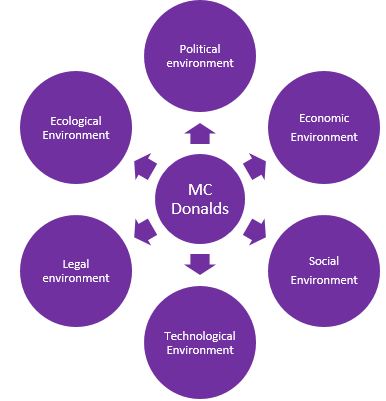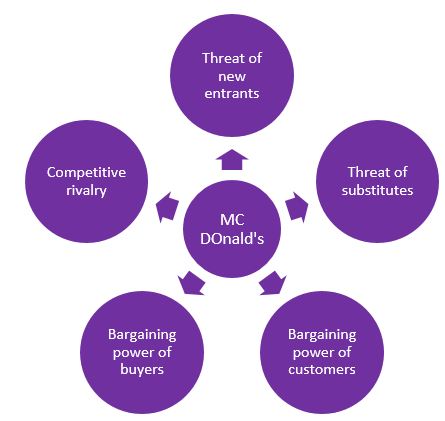Introduction
PESTEL, SWOT and Porter’s Five Forces Model of MC Donald’s will be conducted in this report. PESTEL is an acronym for Political, Economic, Social, Technological, Environmental and Legal. PESTEL Analysis is a tool used to identify and analyze the key drivers of change in the macro environment. SWOT Analysis is a tool used to identify the Strengths, Weaknesses, Opportunities and Threats of an organization. PESTEL and SWOT are both analytical tools that can be used to identify the key drivers of change in the macro environment. Porter’s Five Forces Model is used to identify the competitive forces that shape an industry. The model includes five forces: buyers, suppliers, substitutes, new entrants and industry rivalry.
You may feel interested to read the blogs:
Business Model Canvas and Corporate Structure of MC Donald’s
Macro Analysis of MC Donald’s
External Environment Analysis of Marriott International
PESTLE Analysis
PESTLE analysis in the below figure shows the influence of the external environment on MC Donald’s that helps the company to find out an effective way of interacting with the influences.

Political environment: MC Donald’s has outlets in 119 countries, and the political environment of these countries has a great influence on the operations of the company (Craft, 2020). For example, the political environment of India is restless therefore, terrorism, Naxalism, religious violence and caste-related valance are created in the country (Mitra, and Ray, 2014). As a result, people cannot lead a normal life and lead life with fear therefore, sales of MC Donald’s in India decreased. It harms the profit level of the company.
Economic environment: Economic factors of host countries have a great influence on MC Donald’s. For example, the USA is one of the most financially stable countries, and the capital per income of the country is 54541.70 (Trading Economics, 2020). It indicates the higher financial capability of the citizens that have made MC Donald’s capable of generating the highest profit from the country. Because of the financial capability of the citizens, they can afford the foods of MC Donald’s at a higher price which makes them highly profitable.
Socio-cultural environment: Social beliefs, culture, etcetera socio-cultural factors affect MC Donald’s sales. For example, increasing health awareness of people is reducing people’s interest in fast food. Therefore, health-conscious people avoid MC Donald’s, which decreases its sales across the world. As a result, the profit level decreases.
Technological environment: Technological advancement also played an outstanding role in fostering MC Donald’s growth. For example, the company have developed MC Donald’s App through the app, the company informs customers about their offers, and people place online order online. That helped MC Donald’s to increase sales enormously.
Legal environment: MC Donald’s has to maintain all the rules and regulations of host countries otherwise, the company have to compensate for the rule-breaking issue. For example, MC Donald’s had to pay $26 million because they stole employees’ overtime payments (Business Insider, 2019). Employees take action against the company, and they are compelled to pay to settle the issue.
Ecological environment: MC Donald’s has to take environment-friendly actions to reduce environmental pollution that occurs because of its operations. For example, MC Donald’s has taken steps to reduce carbon emissions by about 36% creates by its restaurants by 2030 (Global Citizen, 2018).
SWOT Analysis of MC Donald’s
Strength, weakness, opportunities and threats are analyzed through a SWOT analysis of MC Donald’s.
| Strength * Brand image of MC Donald’s is one of the key strengths of the company that is created by serving delicious food. * It covers 119 countries which is another key strength of the company (Craft, 2020). * Sustainable supply chain management of MC Donald’s is another strength because it ensures the food standard. * It delivers excellent customer service through its experienced employees, which increases customers’ awareness and is one of the most significant strengths of MC Donald’s. * MC Donald’s has a large and diverse menu across the world that ensures enormous sales by attracting millions of customers globally. | Weakness * MC Donald’s is over-dependent on its franchisees therefore, the franchisees have extra control in the business. * It depends on the western market too much to generate high revenue. |
| Opportunities * Emphasizing digital marketing will help them increase their market share globally. * Menu innovation can increase the profit level of the company. * Focusing on the Asian market will bring higher revenue than like Western market. | Threats * Competition in both international and local markets in the fast-food industry is becoming higher. * Higher government control is increasing operating costs and creating pressure on overseas markets while expanding business. |
Porter’s Five Forces Model
The competitiveness of MC Donald’s is evaluated through Porter’s five forces analysis in the figure.

The threat of new entrants: Threat of new entrants is medium for MC Donald’s (Talpau, and Boscor, 2011). New companies provide foods of lower costs that will attract most of the customers. But the brand image and customers’ trust in MC Donald’s will need a long time to develop by new entrants.
Threat of new substitutes: The threat of substitutes is higher for MC Donald’s (Andreani, Taniaji, and Puspitasari, 2012). The prices of the substitutes are low, and people can make these foods at home. Therefore, customers avoid MC Donald’s food. They have to maintain the quality of their foods to keep them different from the substitutes.
Bargaining power of suppliers: Suppliers have low power to influence MC Donald’s (Thompson, Strickland, and Gamble, 2015). There is a large number of suppliers, and the availability of raw materials makes suppliers less powerful. MC Donald’s can manage therefore, the suppliers do not try to control the distribution network.
Bargaining power of byers: Customers of MC Donald’s have high bargaining power because there is a large number of service providers in the fast food industry (Randall, Day, G. and Moorman, 2013). Switching costs are lower which reduces the demand for MC Donald’s products. Therefore, the company have to develop effective strategies to hold onto customers.
Competitive rivalry: KFC, Burger King, Subway, Starbucks, Dunkin brands, Pizza Hut etcetera are the top competitors of MC Donald’s (Owler, 2020). All of the companies deliver delicious foods and excellent customer experience with an affordable range that attracts customers toward them. MC Donald’s faces high competitive rivalry in both the international market and local market of host countries.
Reference
Craft, 2020. McDonald’s. Retrieved from: https://craft.co/mcdonald-s. [Assessed on: 1 April, 2020]
Trading Economics, 2020. United States GDP per capita. Retrieved from: https://tradingeconomics.com/united-states/gdp-per-capita. [Assessed on: 4 April, 2020]
